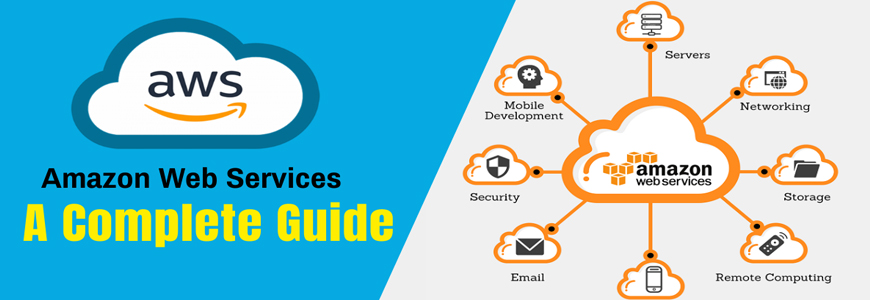
Amazon Web Service
Amazon Web Services (AWS) began offering IT infrastructure services to businesses in the form of web services -- now commonly known as cloud computing. One of the key benefits of cloud computing is the opportunity to replace up-front capital infrastructure expenses with low variable costs that scale with your business. With the Cloud, businesses no longer need to plan for and procure servers and other IT infrastructure weeks or months in advance. Instead, they can instantly spin up hundreds or thousands of servers in minutes and deliver results faster.
Today, Amazon Web Services provides a highly reliable, scalable, low-cost infrastructure platform in the cloud that powers hundreds of thousands of businesses in 190 countries around the world. With data center locations in the U.S., Europe, Brazil, Singapore, Japan, and Australia, customers across all industries are taking advantage

What Is AWS Exactly?
AWS is made up of so many different cloud computing products and services. The highly profitable Amazon division provides servers, storage, networking, remote computing, email, mobile development, and security. AWS can be broken into three main products: EC2, Amazon’s virtual machine service, Glacier, a low-cost cloud storage service, and S3, Amazon’s storage system. AWS is so large and present in the computing world that it's far outpaced its competitors. As of February 2020, one independent analyst reports AWS has over a third of the market at 32.4%, with Azure following behind at half that amount 17.6%, and Google Cloud at 6%.
AWS has 76 availability zones in which its servers are located. These serviced regions are divided in order to allow users to set geographical limits on their services (if they so choose), but also to provide security by diversifying the physical locations in which data is held. Overall, AWS spans 245 countries and territories.
Which AWS Service We ProvideAt Manifest Technologies We provide Compute , Storage , Databases , Migration & Transfer , Network & Content Delivery , Management &Governance , Analytics , Security , Identity & Compliance , Desktop & App Streaming , Machine Learning , Artificial Intelligance , Domain Registration , Domain Purchase , Route 53 , Internet Of Things , Serverless.
Cost SavingsAmazon Web Services to the utility companies of the early 1900s. One hundred years ago, a factory needing electricity would build its own power plant but, once the factories were able to buy electricity from a public utility, the need for pricey private electric plants subsided. AWS is trying to move companies away from physical computing technology and onto the cloud.
Traditionally, companies looking for large amounts of storage would need to physically build a storage space and maintain it. Storing on a cloud could mean signing a pricey contract for a large amount of storage space that the company could “grow into”. Building or buying too little storage could be disastrous if the business took off and expensive if it didn’t.
The same applies to computing power. Companies that experience surge traffic would traditionally end up buying loads of power to sustain their business during peak times. On off-peak times—May for tax accountants for example—computing power lays unused, but still costing the firm money.
With AWS, companies pay for what they use. There’s no upfront cost to build a storage system and no need to estimate usage. AWS customers use what they need and their costs are scaled automatically and accordingly.
Scalable and AdaptableSince AWS’s cost is modified based on the customers’ usage, start-ups and small businesses can see the obvious benefits of using Amazon for their computing needs. In fact, AWS is great for building a business from the bottom as it provides all the tools necessary for companies to start up with the cloud. For existing companies, Amazon provides low-cost migration services so that your existing infrastructure can be seamlessly moved over to AWS.
As a company grows, AWS provides resources to aid in expansion and as the business model allows for flexible usage, customers will never need to spend time thinking about whether or not they need to reexamine their computing usage. In fact, aside from budgetary reasons, companies could realistically “set and forget” all their computing needs.
Security and ReliabilityArguably, Amazon Web Services is much more secure than a company hosting its own website or storage. AWS currently has dozens of data centers across the globe which are continuously monitored and strictly maintained. The diversification of the data centers ensures that a disaster striking one region doesn’t cause permanent data loss worldwide. Imagine if Netflix were to have all of its personnel files, content, and backed-up data centralized on-site on the eve of a hurricane. Chaos would ensue.
In fact, localizing data in an easily identifiable location and where hundreds of people can realistically obtain access is unwise. AWS has tried to keep its data centers as hidden as possible, locating them in out-of-the-way locations and allowing access only on an essential basis. The data centers and all the data contained therein are safe from intrusions, and, with Amazon’s experience in cloud services, outages and potential attacks can be quickly identified and easily remedied, 24 hours a day. The same can’t be said for a small company whose computing is handled by a single IT specialist working out of a large office.
The Bottom LineAmazon Web Services is a cash cow for Amazon. The services are shaking up the computing world in the same way that Amazon is changing America’s retail space. By pricing its cloud products extremely cheaply, Amazon can provide affordable and scalable services to everyone from the newest start-up to a Fortune 500 company.
